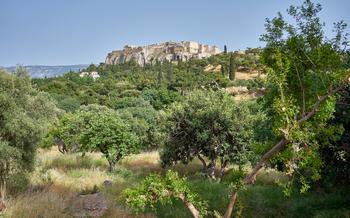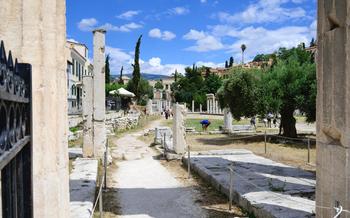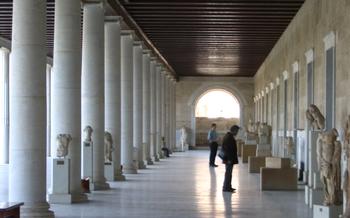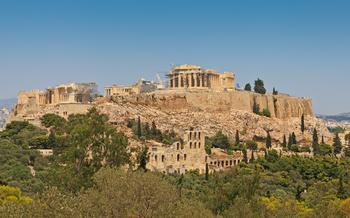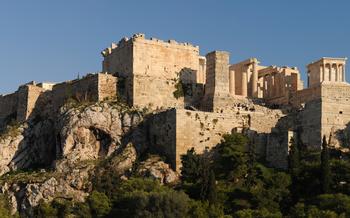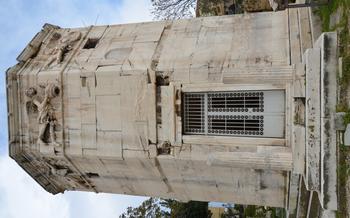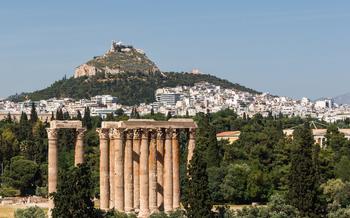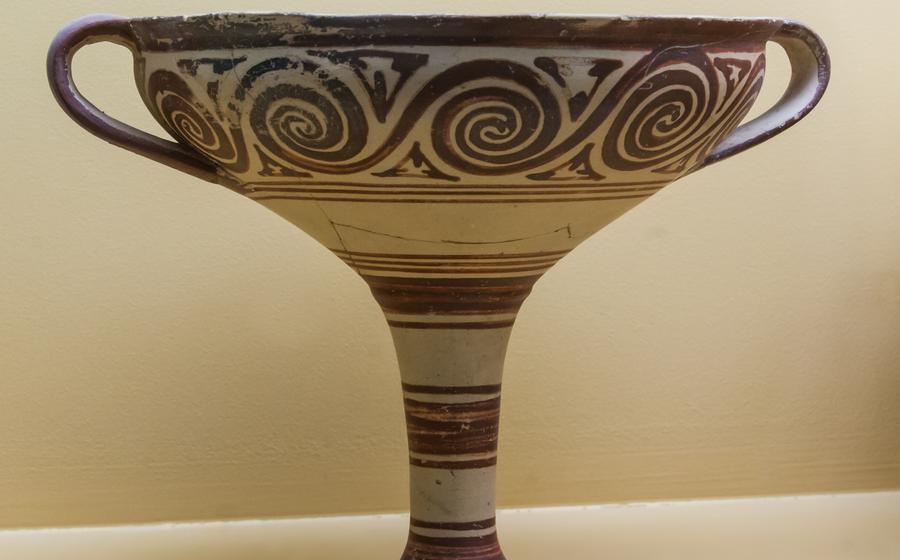
Museum of the Ancient Agora
- Historical Significance
- Main Attractions
- Museum of the Ancient Agora
- Historical Figures
- Agora Excavations
- Temple of Apollo Patroos
- Stoa Poikile
- South Stoa
- Odeon of Agrippa
- Herakleion
- Statue of Demosthenes
- Tower of the Winds
- Church of the Holy Apostles
- Insider Tip:
Historical Significance
Located at the foot of the Acropolis, the ancient Agora was the heart of ancient Athens, a bustling marketplace and a center of political, commercial, and social activities. Here, citizens gathered to buy and sell goods, discuss politics, attend trials, and witness religious ceremonies. The Agora was the birthplace of democracy, where the world's first democratic government was established in the 6th century BC. It was here that the Athenian assembly met to make laws, debate policies, and decide on matters of war and peace. The Agora remained a vibrant center of Athenian life until the Roman period when it gradually declined in importance. Its ruins, however, still stand today as a testament to the glory of ancient Athens and the birthplace of democracy.
Main Attractions
Amidst the ruins of the Ancient Agora, several notable structures stand as testaments to the grandeur of ancient Athens. The Temple of Hephaestus, also known as Theseion, is one of the best-preserved ancient Greek temples, showcasing Doric architecture in its full glory. Its well-proportioned columns and intricate sculptures offer a glimpse into the architectural prowess of the ancient Greeks.
The Stoa of Attalos, meticulously reconstructed in the early 20th century, serves as a stunning example of a Hellenistic marketplace. Originally built in the 2nd century BC, it now houses the Museum of the Ancient Agora. Its restored shops and colonnades provide a glimpse into the bustling commercial activities that once took place in the Agora.
Another significant monument is the Altar of the Twelve Gods, where sacrifices were offered to honor the Olympian deities. This impressive altar, dating back to the 6th century BC, stands as a testament to the religious practices and beliefs of ancient Athens.
Museum of the Ancient Agora
The Museum of the Ancient Agora is a treasure trove of artifacts that provide a glimpse into the daily lives of ancient Athenians. Located within the Stoa of Attalos, a reconstructed ancient marketplace, the museum houses a vast collection of pottery, sculptures, and everyday objects excavated from the Agora.
Interactive exhibits and multimedia presentations bring the ancient Agora to life, allowing visitors to experience the bustling marketplace, the political debates, and the vibrant cultural life that characterized this central hub of ancient Athens. One of the most fascinating exhibits is a collection of ostraka, broken pottery shards used for voting in ancient Athens. These ostraka provide valuable insights into the Athenian democratic process and the decisions made by the Assembly.
The museum's collection also includes a significant number of inscriptions, which are crucial for understanding ancient Athenian law and society. These inscriptions record laws, decrees, treaties, and financial transactions, providing a wealth of information about the functioning of the ancient Athenian state.
Through its artifacts, exhibits, and educational programs, the Museum of the Ancient Agora offers visitors a unique opportunity to explore the history, culture, and daily life of ancient Athens, gaining a deeper understanding of the birthplace of democracy and one of the most influential civilizations in human history.
Historical Figures
Famous Philosophers, Statesmen, and Orators
The Agora was not just a place of commerce and administration; it was also a hub of intellectual and political discourse. Many famous philosophers, statesmen, and orators frequented the Agora, engaging in lively debates and discussions that shaped the course of Athenian history.
One of the most renowned figures associated with the Agora was Socrates. Socrates was a philosopher who believed in the power of reason and critical thinking. He often engaged in conversations with his students and fellow Athenians in the Agora, questioning their beliefs and challenging them to think more deeply about the world around them.
Another prominent figure was Plato, a student of Socrates who went on to become a philosopher in his own right. Plato founded the Academy, a philosophical school that was located near the Agora. The Academy was a place where students could study philosophy, politics, and other subjects.
Demosthenes, a famous orator, also spent much of his time in the Agora. Demosthenes was known for his powerful speeches, which often swayed the opinions of the Athenian assembly. He played a key role in shaping Athenian politics and was a strong advocate for democracy.
These are just a few of the many historical figures who frequented the Agora. Their presence helped to make the Agora a place of great intellectual and political ferment, and their ideas and contributions continue to influence our world today.
Agora Excavations
The discovery of the Ancient Agora is a testament to the dedication and perseverance of archaeologists. Excavations began in the late 19th century under the direction of the Greek Archaeological Society. The initial focus was on the Temple of Hephaestus, and the efforts soon expanded to uncover the rest of the Agora.
The excavations were not without their challenges. The site was covered in a layer of earth and rubble, and the archaeologists had to proceed carefully to avoid damaging any remaining structures. Additionally, the Agora was located in the heart of modern Athens, which meant that the archaeologists had to work around existing buildings and infrastructure.
Despite the challenges, the excavations were a resounding success. The archaeologists uncovered a wealth of artifacts, including pottery, sculptures, and inscriptions. These artifacts provided valuable insights into the daily lives of ancient Athenians and helped to reconstruct the history of the Agora.
One of the most significant discoveries was the Stoa of Attalos, a well-preserved ancient marketplace. The stoa was reconstructed in the 1950s and now houses the Museum of the Ancient Agora. The museum displays many of the artifacts found during the excavations, and it provides visitors with a fascinating glimpse into the history of this important site.
Temple of Apollo Patroos
Located on the north side of the Agora, the Temple of Apollo Patroos is a significant sacred site dedicated to the deity Apollo. Apollo, revered in ancient Greek religion and mythology as the god of music, poetry, prophecy, and healing, held a special place in Athenian religious devotion. The temple's construction dates back to the 6th century BC, making it one of the earliest structures in the Agora.
Apollo Patroos, meaning "Apollo of the Father," was worshipped in this temple as a protector and guardian of the city. The temple's placement within the Agora, the bustling center of Athenian life, underscores the importance of religion in ancient Greek society. The temple's design reflects the architectural style of the Archaic period, characterized by its simplicity and the use of poros stone.
While the temple is now in ruins, its remnants still evoke a sense of awe and reverence. Visitors can admire the well-preserved foundations and marvel at the intricate sculptures that once adorned its pediments and metopes. These sculptures, crafted with exquisite detail, depicted scenes from Greek mythology related to Apollo and his exploits.
Exploring the Temple of Apollo Patroos offers a glimpse into the religious beliefs and practices of ancient Athenians. It serves as a reminder of the deep connection between religion and everyday life in the ancient world. Visitors to the Agora can immerse themselves in the spiritual atmosphere of this sacred site and gain a deeper understanding of the role that religion played in shaping ancient Athenian society.
Stoa Poikile
Another noteworthy site in the Agora is the Stoa Poikile, which translates to "Painted Porch." This stoa, or covered walkway, was adorned with beautiful frescoes depicting scenes from Greek mythology and history. These frescoes were so famous that the stoa became known as the "Painted Porch."
The Stoa Poikile served as a gathering place for philosophers, artists, and intellectuals. It was here that the philosopher Zeno founded the Stoic school of philosophy, which emphasized reason and self-control. The Stoa Poikile was also a popular meeting place for the city's elite, who would come to discuss politics, philosophy, and the arts.
Today, only the foundations of the Stoa Poikile remain, but it is still possible to imagine the vibrant atmosphere that once filled this space. The stoa's ruins offer a glimpse into the cultural and intellectual life of ancient Athens.
South Stoa
The South Stoa was a prominent building in the Ancient Agora of Athens, located on its southern side. Although its foundations and architectural remains are all that can be seen today, the South Stoa played a significant role in the commercial and social life of ancient Athens.
Constructed in the 5th century BC, the South Stoa was a long, colonnaded building that stretched along the southern edge of the Agora. It served as a marketplace, with shops and stalls selling a variety of goods, from pottery and textiles to food and drink. The stoa's strategic location made it a popular destination for both locals and visitors to the city.
In addition to its commercial function, the South Stoa also served as a place for public gatherings and assemblies. Citizens would gather here to discuss political issues, conduct business, and socialize. The stoa's open and airy design provided a comfortable and inviting space for people to meet and interact.
The ruins of the South Stoa offer a glimpse into the bustling commercial and social activities that took place in the Ancient Agora. Visitors can imagine the lively atmosphere as merchants hawked their wares, shoppers bartered for goods, and citizens engaged in lively debates and discussions.
Odeon of Agrippa
The Odeon of Agrippa, located on the west side of the Agora, was a small theater built by Marcus Vipsanius Agrippa, a close friend and advisor to the Roman Emperor Augustus. Constructed in the 1st century BC, the Odeon was a significant addition to the cultural landscape of ancient Athens.
With a seating capacity of approximately 1,000, the Odeon hosted a variety of artistic events, including musical performances, poetry readings, and other cultural activities. Its intimate size and excellent acoustics made it an ideal venue for small-scale performances and recitals.
The Odeon's architectural design featured a semi-circular auditorium with tiered seating arranged around a central stage. The stage was adorned with elaborate marble decorations and statues, creating a visually stunning backdrop for the performances.
The Odeon of Agrippa played a vital role in the cultural and entertainment life of ancient Athens. It was a place where people from all walks of life could gather to enjoy the arts and celebrate the rich cultural heritage of their city.
Today, the Odeon's ruins stand as a testament to the vibrant cultural scene of ancient Athens. Visitors can explore the remains of the theater and imagine the lively atmosphere that once filled this space, as performers and audiences alike came together to experience the magic of art and entertainment.
Herakleion
Explore the ruins of the Herakleion, a temple dedicated to the hero Herakles (Hercules).
Located on the east side of the Agora, the Herakleion was built in the 5th century BC to honor the hero Herakles, who was revered for his strength and courage. The temple was a significant religious site in ancient Athens, and it was used for ceremonies and festivals dedicated to the hero.
Learn about the significance of Herakles in Greek mythology and his connection to the Agora.
Herakles was one of the most popular and widely worshipped heroes in Greek mythology. He was known for his twelve labors, which he undertook to atone for a crime he had committed. The Agora was a place where Herakles was often celebrated, and his exploits were depicted in works of art and literature.
Discover the role of the Herakleion in religious ceremonies and festivals held in honor of the hero.
The Herakleion was a central location for religious ceremonies and festivals honoring Herakles. These events were often elaborate and involved sacrifices, processions, and other rituals. The temple was also a place where people could come to pray to Herakles and seek his protection.
Insider Tip:
- Visit the Herakleion at sunset to enjoy the beautiful views of the Agora and the surrounding hills.
Statue of Demosthenes
Another noteworthy attraction in the Ancient Agora is the statue of Demosthenes, one of Athens' most influential historical figures. Standing near the northwest corner of the Agora, this statue pays tribute to the great orator who played a pivotal role in shaping the city's political landscape. Demosthenes was a staunch advocate for democracy and his speeches, known for their eloquence and passion, rallied the Athenian people to resist the expansionist ambitions of Philip II of Macedon. His unwavering commitment to Athenian independence earned him the respect and admiration of his fellow citizens, and this statue stands as a testament to his legacy.
As you admire the statue of Demosthenes, take a moment to reflect on his contributions to Athenian democracy. His powerful oratory and unwavering dedication to the principles of freedom and equality left an enduring mark on the course of Athenian history. Demosthenes' legacy continues to inspire those who believe in the power of words and the importance of fighting for what they believe in.
Tower of the Winds
Another fascinating landmark in the Ancient Agora is the Tower of the Winds, an ancient sundial and weather vane that stands as a testament to ancient Greek scientific knowledge and ingenuity. Erected in the 1st century BC, the tower is an octagonal structure adorned with intricate reliefs depicting the eight wind deities. Each side of the tower features a sundial, allowing Athenians to tell time accurately throughout the day.
The Tower of the Winds also functioned as a weather vane, with a bronze triton on its roof that rotated to indicate the direction of the wind. This innovative design made the tower a valuable tool for sailors, farmers, and other Athenians who relied on weather conditions for their daily lives.
In addition to its practical functions, the Tower of the Winds was also a symbol of Athenian intellectual prowess. Its construction demonstrates the Greeks' mastery of astronomy, meteorology, and architecture. The tower's reliefs and inscriptions reveal the Greeks' keen observations of the natural world and their ability to translate scientific knowledge into artistic expression.
Today, the Tower of the Winds stands as a reminder of the ingenuity and creativity of ancient Athenians. Its intricate carvings, innovative design, and historical significance make it a must-see for anyone interested in ancient Greek culture and science.
Church of the Holy Apostles
Nestled in the heart of the Ancient Agora, the Church of the Holy Apostles stands as a testament to Athens' rich religious history. Dating back to the 10th century AD, this Byzantine church played a pivotal role in the Christianization of the city. Its well-preserved ruins offer a glimpse into the architectural and artistic achievements of the Byzantine era.
Visitors can explore the church's remains, admiring its intricate stonework, decorative mosaics, and remnants of frescoes that once adorned its interior. The church's central dome, though partially collapsed, still evokes the grandeur of Byzantine architecture.
The Church of the Holy Apostles served as a place of worship for the early Christian community in Athens. It witnessed significant religious ceremonies, including baptisms, marriages, and the celebration of Christian holidays. The church's location within the Agora, the bustling center of ancient Athenian life, highlights the growing influence of Christianity in the city.
Today, the ruins of the Church of the Holy Apostles stand as a reminder of Athens' diverse religious heritage. Its presence within the Ancient Agora serves as a bridge between the city's classical past and its Christian legacy, inviting visitors to explore the layers of history that have shaped this vibrant metropolis.
Insider Tip:
To make the most of your visit to the Ancient Agora and surrounding areas, consider purchasing a combined ticket. This ticket grants you access to not only the Museum of the Ancient Agora but also to several other nearby attractions, including the Acropolis Museum and the Temple of Olympian Zeus. This is a great way to save money and time, as you won't have to purchase separate tickets for each attraction.
The combined ticket typically includes admission to all of the major archaeological sites and museums in the area, allowing you to explore the ancient wonders of Athens at your own pace. By purchasing a combined ticket, you can avoid the hassle of queuing for tickets at each attraction, ensuring a smoother and more enjoyable experience.
So, if you're planning to visit multiple attractions in Athens, be sure to inquire about a combined ticket. It's an excellent way to save on costs, maximize your time, and fully immerse yourself in the history and culture of this captivating city.
